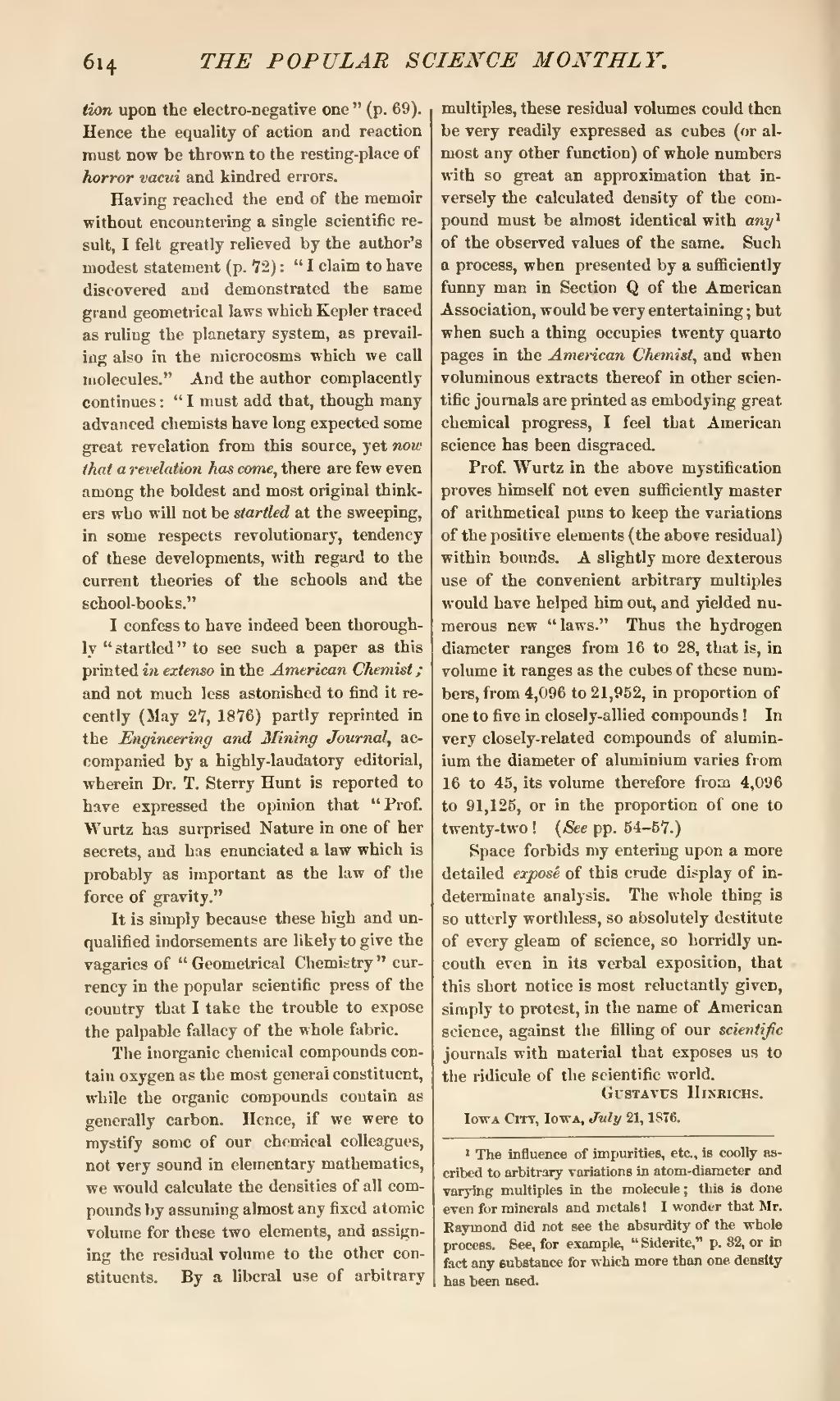tion upon the electro-negative one" (p. 69). Hence the equality of action and reaction must now be thrown to the resting-place of horror vacui and kindred errors.
Having reached the end of the memoir without encountering a single scientific result, I felt greatly relieved by the author's modest statement (p. 72): "I claim to have discovered and demonstrated the same grand geometrical laws which Kepler traced as ruling the planetary system, as prevailing also in the microcosms which we call molecules." And the author complacently continues: "I must add that, though many advanced chemists have long expected some great revelation from this source, yet now that a revelation has come, there are few even among the boldest and most original thinkers who will not be startled at the sweeping, in some respects revolutionary, tendency of these developments, with regard to the current theories of the schools and the school-books."
I confess to have indeed been thoroughly "startled" to see such a paper as this printed in extenso in the American Chemist; and not much less astonished to find it recently (May 27, 1876) partly reprinted in the Engineering and Mining Journal, accompanied by a highly-laudatory editorial, wherein Dr. T. Sterry Hunt is reported to have expressed the opinion that "Prof. Wurtz has surprised Nature in one of her secrets, and has enunciated a law which is probably as important as the law of the force of gravity."
It is simply because these high and unqualified indorsements are likely to give the vagaries of "Geometrical Chemistry" currency in the popular scientific press of the country that I take the trouble to expose the palpable fallacy of the whole fabric.
The inorganic chemical compounds contain oxygen as the most general constituent, while the organic compounds contain as generally carbon. Hence, if we were to mystify some of our chemical colleagues, not very sound in elementary mathematics, we would calculate the densities of all compounds by assuming almost any fixed atomic volume for these two elements, and assigning the residual volume to the other constituents. By a liberal use of arbitrary multiples, these residual volumes could then be very readily expressed as cubes (or almost any other function) of whole numbers with so great an approximation that inversely the calculated density of the compound must be almost identical with any[1] of the observed values of the same. Such a process, when presented by a sufficiently funny man in Section Q of the American Association, would be very entertaining; but when such a thing occupies twenty quarto pages in the American Chemist, and when voluminous extracts thereof in other scientific journals are printed as embodying great chemical progress, I feel that American science has been disgraced.
Prof. Wurtz in the above mystification proves himself not even sufficiently master of arithmetical puns to keep the variations of the positive elements (the above residual) within bounds. A slightly more dexterous use of the convenient arbitrary multiples would have helped him out, and yielded numerous new "laws." Thus the hydrogen diameter ranges from 16 to 28, that is, in volume it ranges as the cubes of these numbers, from 4,096 to 21,952, in proportion of one to five in closely-allied compounds! In very closely-related compounds of aluminium the diameter of aluminium varies from 16 to 45, its volume therefore from 4,096 to 91,125, or in the proportion of one to twenty-two! (See pp. 54-57.)
Space forbids my entering upon a more detailed exposé of this crude display of indeterminate analysis. The whole thing is so utterly worthless, so absolutely destitute of every gleam of science, so horridly uncouth even in its verbal exposition, that this short notice is most reluctantly given, simply to protest, in the name of American science, against the filling of our scientific journals with material that exposes us to the ridicule of the scientific world.
| Gustavus Hinrichs. |
| Iowa City, Iowa, July 21, 1876. |
- ↑ The influence of impurities, etc., is coolly ascribed to arbitrary variations in atom-diameter and varying multiples in the molecule; this is done even for minerals and metals! I wonder that Mr. Raymond did not see the absurdity of the whole process. See, for example, "Siderite," p. 82, or in fact any substance for which more than one density has been used.
